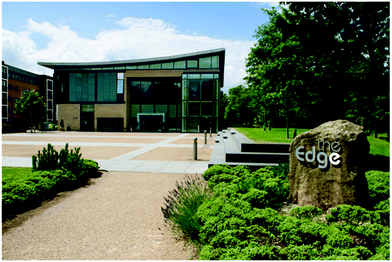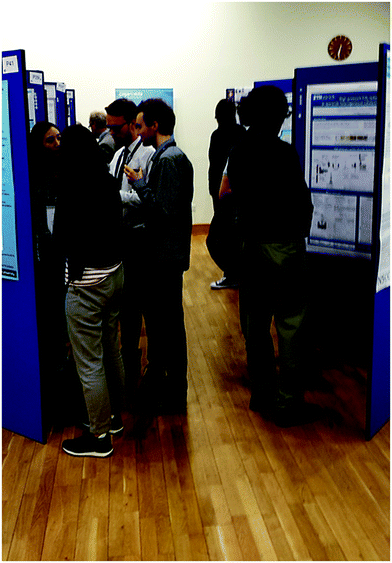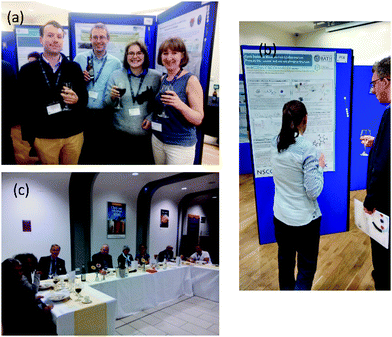Highlights from the Faraday Discussion on Carbon Dioxide Utilisation, Sheffield, UK, September 2015
José A.
Castro-Osma
*a,
Jennifer R.
Dodson
b,
Ian D. V.
Ingram
b,
Matt
Moss
c,
Michael
North
b,
Elsje Alessandra
Quadrelli
d,
Laura
Quintana-Gómez
e,
Dan G.
Reed
c,
Peter
Styring
c and
Ana
Villa-Zaragoza
c
aDepartamento de Química Inorgánica, Orgánica y Bioquímica-Centro de Innovación en Química Avanzada (ORFEO-CINQA), Facultad de Ciencias y Tecnologías Químicas, Universidad de Castilla-La Mancha, 13071-Ciudad Real, Spain. E-mail: JoseAntonio.Castro@uclm.es
bGreen Chemistry Centre of Excellence, Chemistry Department, University of York, York, YO10 5DD, UK
cUK Centre for Carbon Dioxide Utilization, Department of Chemical & Biological Engineering, The University of Sheffield, Sir Robert Hadfield Building, Sheffield S1 3JD, UK
dCPE Lyon and CNRS, Université de Lyon, ICL, C2P2 UMR 5265 LCOMS (CNRS – CPE Lyon – Univ. Lyon 1), Ecole Supérieure de Chimie Physique Electronique de Lyon, 43 Bd du 11 Novembre 1918, 69616 Villeurbanne, France
eCatalysis Group, Department of Chemical & Biological Engineering, The University of Sheffield, Sir Robert Hadfield Building, Sheffield S1 3JD, UK
First published on 13th November 2015
Faraday Discussions have a distinctive format which is over a century old, and yet has been growing in popularity in recent years. In place of the more usual programme of oral presentations, each speaker instead submits a full paper in advance of the conference and then only presents a 5 minute summary of the work. The remainder of the time is allocated to questions and discussion from the delegates, who have had the opportunity to read the presented papers in advance and prepare their questions. This leads to a rather lively discussion which lies somewhere between traditional conference questions and live, non-anonymous, peer-review. For the vast majority of delegates, speakers, and even conference organisers this was their first time attending a Faraday Discussion and, whilst certainly not for the faint-hearted, the cut and thrust of a healthy discussion was certainly more stimulating than the usual conference format. The Faraday Discussion on Carbon Dioxide Utilisation was the first of its kind on the subject and was held at the Edge Conference Centre at the University of Sheffield (Fig. 1). It was a reflection of the growing importance of Carbon Dioxide Utilisation that delegates from the UK were joined by delegates from 22 other countries spanning all corners of the world.Following a welcome and introduction to the format by Professor Peter Styring (University of Sheffield), the Chair of the Scientific Committee, and the RSC's Publishing Editors for the event, Mary Macleod and Amy Hazlehurst, Professor Sir Martyn Poliakoff (University of Nottingham) gave a highly entertaining lecture on the general subject of CO2 utilisation, and his views on how best to carry the field forward to real applications.
Martyn also distributed a list of criteria, forming the handy acronym “CO2CHEMISTRY”, which suggested how new technologies could be judged for sustainability, and encouraged us to vote for the presented paper that best fit these criteria during the conference.
| C | Catalysis is crucial |
| O | Origin of the CO2? |
| 2 | Tomorrow's world may be different |
| C | Cleaner than the existing process? |
| H | High volume or high value products? |
| E | E-factor must be low |
| M | Maximise integration |
| I | Innovative process technology |
| S | Sustainability is essential |
| T | Thermodynamics cannot be beaten |
| R | Renewable (and reasonable) energy input |
| Y | Your enthusiasm is not enough |
Session 1: Atom efficiency in small molecule and macromolecule synthesis
The first session, chaired by Professor Peter Styring, focused on atom efficiency in small molecule and macromolecule synthesis and featured papers from Dr Richard Heyn (SINTEF, Norway), Christopher Kozak (Memorial University of Newfoundland, Canada) and Dr George Dowson (University of Sheffield) (Fig. 2). The first paper was presented by Dr Heyn on screening homogeneous catalysts for the direct conversion of diols to cyclic carbonates with carbon dioxide (DOI: 10.1039/c5fd00061k). In these reactions, acetonitrile is not only used as solvent but as a drying agent, shifting the equilibrium to the formation of cyclic carbonates. However, the use of acetonitrile resulted in a significant quantity of by-products. One delegate asked if molecular sieves could be used, to which Professor Michael North (University of York), who collaborated with Richard Heyn on the work, responded that the reactions were carried out at elevated temperatures where molecular sieves actually release water rather than trapping it.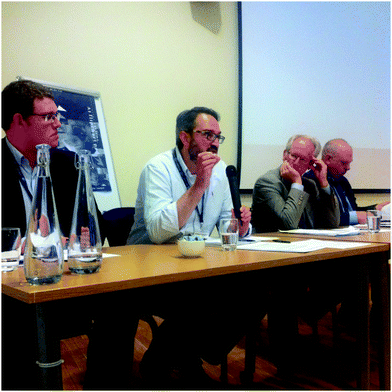 | ||
| Fig. 2 Some of the participants of the first session. From left to right, Dr George Dowson, Dr Christopher Kozak, Dr Richard Heyn and Professor Peter Styring. | ||
Dr Kozak presented some exciting MALDI-MS analysis of his class of chromium catalysts and their resulting polymers (DOI: 10.1039/c5fd00046g). Professor Charlotte Williams (Imperial College London) made a comment regarding the kinetics of Kozak's system as well as the cautionary observation that downstream users of polymers are often wary of materials that might contain traces of chromium. This often also has the undesirable consequence of leaving the materials discoloured, which can limit their usefulness.
In the closing paper of the session George Dowson discussed the feasibility of capturing CO2 with Grignard reagents (DOI: 10.1039/c5fd00049a). The use of magnesium Grignard chemistry for CO2 capture came under particular scrutiny, especially the recycling of magnesium from Mg2+ at the end of the reaction, back to Mg0 whilst only one of these electrons is transferred to CO2 in forming the carboxylic acid product. It was also acknowledged by the author that, despite the surprisingly high efficiency of electrolytic recycling of magnesium, the value of the carboxylic acids discussed were too low to make the approach economically viable unless carried out on a very large scale.
Following a break for tea, the session resumed with Charlotte Williams presenting her ongoing work on the copolymerisation of cyclohexene oxide with CO2 using dinuclear catalysts (DOI: 10.1039/c5fd00073d). Discussion around Charlotte's work, which was familiar to many in the audience, focused on her system's tolerance to impurities likely to be present in captured CO2 such as water and amines, the effects of which she had investigated. In particular, the phenomenon of chain transfer and its effect on the polymer were of interest.
Following this, Professor Carmine Capacchione (University of Salerno, Italy) presented his thioether-triphenolate iron catalysts for the production of cyclic carbonates from epoxides (DOI: 10.1039/c5fd00070j). As might be expected, Capaccione's very active catalyst was the subject of a lot of (good-natured) probing, particularly regarding the mechanism, since a large excess of the tetrabutylammonium bromide (TBAB) co-catalyst was used to achieve the best results. North questioned whether the TOFs quoted should be adjusted to reflect the fact that the catalyst contained two metal centres and is not believed to act via a bimetallic mechanism, making it in effect two conjoined catalysts acting independently. This sparked a brief discussion amongst several delegates about the pitfalls of using TOF as a measure of catalytic activity when applied to catalysts where multiple active sites may be involved.
The session was closed with a series of 30 second “lightning flash” presentations to highlight selected posters to be presented at the conference's two poster sessions. Needless to say, a large number of speakers summarising their work in only thirty seconds made for a very intense and rapid-fire session! As the session closed, Martyn Poliakoff was formally awarded an Honorary Fellowship of the RSC (Fig. 3) and he took the opportunity, perhaps inspired by the younger delegates in the “lightning flash” presentations, to advise early-career researchers to do research for the good of society and for the love of it, rather than obsessing over impact factors and other artificial measures of research success.
The poster session followed and, with interest piqued by the flash presentations, was notably successful with many of the posters surrounded by a cluster of interested delegates asking questions (Fig. 4).
Session 2: CO2 reduction reactions
The topic of Session 2 was CO2 reduction reactions and was divided into three different topics: electrocatalytic reduction of CO2, hydrothermal conversion of CO2 and conversion of CO2 driven by plasma. Regarding the electrocatalytic reduction of CO2, two papers were presented. Both contributions described their work in the overarching effort to facilitate renewable energy utilisation. In particular, its connection with carbon dioxide utilisation to lead to the sustainable synthesis of useful feedstocks, was addressed. Some of these molecules are drop-in fuels for current infrastructures. Both papers presented solutions aimed at increasing the Faradaic efficiency and selectivity of the CO2 electroreduction by improving the electrocatalyst’s performance, either by an improved cell design or by an improved grafted electrocatalyst of molecular composition.The first work was presented by Professor Gabriele Centi (University of Messina, Italy). The paper focused on the design of a new electrochemical cell for the electrocatalytic reduction of CO2 (DOI: 10.1039/c5fd00069f). The cathodic compartments of the cells displayed the common original feature of being electrolyte-less, hence allowing the reduction of gaseous CO2 on the gas diffusion electrode. The cathodic compartments were fitted with a carbon-based cathode with metal nanoparticles acting as electro-chemical catalysts. The results obtained for CO2 electrochemical reduction by varying the carbon type supports (carbon black, nanotubes) and the metal type nanoparticles (M = Cu, Co, Fe or Pt) in various electrodes showed that H2 and only some of the several possible C-based CO2 reduction products were obtained (namely formic acid, acetic acid and methyl formate). Noticeably, no CO, methane or other hydrocarbon was detected. Based on these results, preliminary mechanistic hypotheses were presented. The performances obtained in the electrolyte-less devices were compared with the corresponding performance obtained with a device working with an electrolyte, hence achieving CO2 reduction in solution as opposed to the gas phase. The best system achieved a better overall TON than a previous liquid-phase literature precedent.
The second paper was presented by Alexander Cowan (University of Liverpool). He reported the fabrication of highly active cathodes for the electrocatalytic reduction of CO2 to CO by a supported catalyst (DOI: 10.1039/c5fd00071h). The focus was on immobilising known homogeneous electrocatalysts, manganese complexes of the general formula [Mn(L)(CO)3Br] (L being an unsubstituted or a t-Bu substituted bipyridine ligand) and novel variants of the same family of Mn(I) complexes (containing carboxylic and hydroxyl-substituents on the bipyridine linkers). The immobilisation was performed by slow evaporation of a casting solution containing the complex NAFION and multi-walled carbon nanotubes. The electrochemical characterisation of the novel complexes was performed using cyclic voltammetry, and IR-SEC. The immobilised t-Bu substituted analogue showed improved selectivity toward CO production with respect to the already known analogous pure bipyridine system. The carboxy- and hydroxyl-substituted ligands showed little activity.
After a short break, three different processes for CO2 utilisation were proposed based on the reduction of CO2. Xian Du (University of Oxford) presented the results of the catalytic dehydrogenation of propane to produce propene using 5 wt%-Cr2O3/ZrO2 as catalyst at 500 °C (DOI: 10.1039/c5fd00062a). He also highlighted, based on thermodynamic calculations, the potential for the use of solar thermal energy for the dehydrogenation of C3H8 compared to the dehydrogenation of C2H6 and C4H10. During the discussion, he was asked, among other questions, about the economic feasibility of the process presented regarding the value of propene versus the separation costs, due to the low yield reached. Du also affirmed during discussion that the CO2 in this reaction acted more as a promoter to avoid further cracking than as a reactant itself.
The second paper was presented by Koen Michiels (Flemish Institute for Technological Research, Belgium). He briefly described the hydrothermal conversion of CO2 into formic acid with zero-valent iron in a two-step process: the first step consisted of the production of hydrogen from water at a temperature of 160 °C and in the second step the CO2 reacted with the H2 at temperatures between 250 °C and 350 °C to produce formic acid (DOI: 10.1039/c5fd00104h). Further discussion of this paper was focused on the use of Fe waste for this kind of reaction as well as alternative uses of the metal waste. The importance of the particle size in these reactions was also discussed and the difficulties that separation processes present for the separation of the products from water were considered.
Another route for CO2 utilisation was explained by Professor Moti Herskowitz (Ben-Guiron University of the Negev, Israel). Professor Herskowitz pointed out the economic disadvantage of reacting CO2 and H2 in the near future due to the fact that current technologies for hydrogen production from water are not competitive (DOI: 10.1039/c5fd00039d). As an alternative, he proposed the use of natural gas, biogas and biomass for the production of CO2, H2 and CO mixtures as a starting material for the preparation of chemicals and fuels. In his paper a kinetic model of the water-gas shift reaction (RWGS), Fischer–Tropsch synthesis (FTS) and methanation reaction was developed for a Fe–Al–O spinel catalyst; the role of potassium as a promoter was also investigated. His affirmations created controversy and people from the audience claimed that the production of H2 can be economically feasible in places where electricity is cheap, i.e. Iceland, and that the geographical availability of the starting materials he used also needs to be considered, i.e. biogas availability in the UK is very low. In general, the discussion promoted the idea of approaching the process as a whole and not focusing only on the use of CO2 to guarantee the sustainability and economic feasibility of the process.
After the lunch break, which gave a great opportunity for networking between the delegates, the afternoon session was chaired by Michele Aresta. Two papers were presented and showcased the latest technology in plasma chemistry and the current challenges and difficulties facing these technologies moving forward to the large scale treatment of CO2. These issues were raised further during the discussion and questions were asked about whether plasma could compete with the chemical reduction of CO2 in terms of volume of CO2 processed.
The first paper, presented by Professor Annemie Bogaerts (University of Antwerp, Belgium), displayed a variety of interesting plasma technologies and focused particularly on the comparison between microwave (MW) and di-electric barrier discharge (DBD) plasmas and the role of vibrational states in CO2 dissociation (DOI: 10.1039/c5fd00053j). For DBDs, both experimental and modelling work was presented which showed good correlation, achieving conversions of up to 35% and energy efficiencies of 8% under various conditions. For MW plasmas the maximum achieved conversions and energy efficiencies are much higher (25% and 35% respectively) which can be explained through the stepwise CO2 dissociation through vibrational levels which are more prevalent in MW discharges.
The second contribution was presented by van Rooij (Dutch Institute for Fundamental Energy Research, The Netherlands), who presented an extensive study of MW plasmas, both modelling and experimental, and further highlighted the importance of vibrational CO2 levels in the dissociation to CO (DOI: 10.1039/c5fd00045a). Conversions of ∼30% and energy efficiencies up to 45% (the thermodynamic maximum) were achieved experimentally, exhibiting superior performance to DBD technology albeit at sub-atmospheric pressure.
Navarrete et al. presented work on a device which converts solar energy to electrical energy which can then be used for chemical transformations. The focus was on converting CO2 to “solar commodities” such as methanol. The novel factor in this research is taking Cu/ZnO used in industry and, by using aerogels, creating a plasmon-tunable catalyst for the reaction of CO to CH3OH. The paper presents details of the catalyst preparation and some initial results of CO2 conversion which fall in line with similar works, albeit at a higher temperature. During the discussion, the question was raised whether the RWGS reaction limits the efficiency of the process as a whole as it is a necessary step to enhance the formation of CO, the precursor to methanol (DOI: 10.1039/c5fd00109a).
Discussion points raised post-presentation focused on the suitability of plasma for large-scale CO2 reduction and whether plasma would be the sole technology involved or one of many technologies. The panel diplomatically stated that although plasma has the advantage of being simple to switch on/off, depending on available excess renewable energy it was likely to be one of a number of different techniques to reduce CO2.
Session 3: Wider impacts
Carbon Dioxide Utilisation (CDU) is a topic that has gained interest in the research, public and industrial communities. There is much discussion about the chemical, economic, environmental and social impacts of this process. It is therefore important to address wider impacts and obtain a general picture of this research area. It is for this reason that a session of the Faraday Discussion with complimentary research was included in the program.The session consisted of three discussions: the environmental potential of CDU in the polyurethane supply chain (DOI: 10.1039/c5fd00067j), presented by Professor André Bardow (RWTH Aachen University, Germany) (Fig. 5), a framework for the analysis of the supply security of utilising carbon dioxide as a chemical feedstock (DOI: 10.1039/c5fd00038f) presented by Professor Eric Fraga (University College London) and investigating public perceptions of CDU technology: a mixed methods study (DOI: 10.1039/c5fd00063g) presented by Dr Christopher Jones (University of Sheffield).
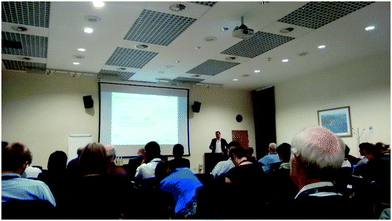 | ||
| Fig. 5 Professor André Bardow from RWTH Aachen University presenting his work on the environmental potential of carbon dioxide utilisation in the polyurethane supply chain. | ||
A general discussion was created between the audience and the presenters, and questions were directed to any of the speakers on any part of their research. The first half of the session was mainly focused on the results presented, while the second half of the session was dominated by the public perception issues. There was an interest in understanding how the carbon sources affected the environmental impacts of the polyurethane supply chain and how carbon credits were assigned. Time horizons, quantities of CO2 to be utilised, and infinite and temporary storage were all part of the discussion. Several comments for the analysis of the security of the supply of the CDU framework were also made. The audience debated the use of turnover frequency as a constant, the reliability of the data and the approach of the study as a qualitative rather than a quantitative one. The counterargument focused on the lack of research maturity since it is still in the early stages. Many parameters and indexes are still being evaluated and depend highly on data availability. However, it was pointed out that there are reliable data contained within the Royal Society of Chemistry's Periodic Table app available from Apple and Android.
The third research presentation generated a lively discussion. There was an interest in finding a method in which CDU could be presented to the public in a non-biased way. Ideas such as having props, considering the size of the focus groups and adjusting the time length of the video were discussed. Results of the research showed that the focus group believed the video was advertising CDU rather than explaining in simple terms what CDU is, its benefits and impacts. However, it was stated during the session that the video was not initially intended for research purposes but rather as a communication tool for the general audience. Overall the discussion stayed positive, trying to address future challenges in reaching the general audience and improving public perception towards CDU. This session exemplified the complexity of CDU and how its connection with other areas such as environmental impacts and public perception issues are important and should be assessed with adequate tools.
Session 4: Capture agents and conversion mechanisms
The works presented during Session 4 of the Faraday Discussion, chaired by Professor Geoffrey Maitland (Imperial College London), showcased work covering the main capture methods currently under intense research. These include solid and liquid sorbents and the use of pressure and temperature swing systems. Work presented by Dr Nathan Hollingsworth (DOI: 10.1039/c5fd00091b) (University College London) and Dr Silvia Madeddu (DOI: 10.1039/c5fd00047e) (Cambridge Carbon Capture) also touched on the direct conversion of CO2 from flue gas without the requirement of the energy intensive capture step.Hollingsworth's work using ionic liquids was of particular interest with ionic liquid research being a relatively hot topic at the moment in the CO2 capture world. As mentioned before, Hollingsworth is looking at CO2 capture and direct electrochemical conversion, which removes the sorbent regeneration energy penalty, which went down well with the audience.
Discussion was active with Professor North stepping up to present some work from the University of York, which looked at solid sorbents in a pressure swing process. North proved that, contrary to belief, microporous structures are not necessary for CO2 capture since he had successfully captured CO2 using mesoporous Starbon®. North's results showed similar results to those in Hasmukh's paper using nanoporous polymers (DOI: 10.1039/c5fd00099h), however Hasmukh was unfortunately not able to make the conference and present his work.
Discussion eventually hit upon a point, which was actually broadly important to all areas of the Faraday Discussion and CO2 utilisation in general. “How pure does the CO2 feed have to be?” In most cases, pure CO2 or CO2–N2 mixtures were used as investigative feed gases for these processes. During the discussion it became apparent that it was very much unknown how some impurities in “real world” flue gas would affect the systems that had been presented. This led to a more important addition later in the Faraday Discussion from both Professors Styring and North that, if we want to successfully research this area, we will need access to facilities that allow testing on “real world” flue gas, which is currently not possible and certainly not at the scales that would be of interest to industry.
Session 5: Biotransformations and biomimetics
The final session of the discussion was aptly extremely varied, focusing on the opportunities for using living organisms, bio-based compounds and light for the utilisation of carbon dioxide. Alessandra Quadrelli (CNRS and Ecole Supérieure de Chimie Physique Electronique de Lyon, France) stepped into the role of Session Chair.Professor Michele Aresta (ChBE-NUS, Singapore and CIRCC, Italy) went on to discuss their work using ZnS decorated with Ru nanoparticles to achieve carboxylation of an unsaturated furan, 2,3-dihydrofuran, using CO2 and visible light. Interestingly, the major observed product was carboxylated 2,5-dihydrofuran from the light induced isomerisation of the furan, with methanol rather than chloroform promoting the carboxylation reaction and production of a single isomer (2,3-dihydrofuran) (DOI: 10.1039/c5fd00040h). Discussion centred on the mechanism and specifically why carboxylation only occurred at the alpha position to the oxygen group and the potential to produce dicarboxylic acids via this process. This is a current line of research along with the use of supercritical CO2 to understand the impacts of solvents on radical stabilisation.
Dr Gonçalo Carrera (LAQV, REQUIMTE, Universidade Nova de Lisboa, Portugal) highlighted his work utilising saccharides including alginic acid, mannose and glucose combined with an organic superbase to capture CO2 (Fig. 6) (DOI: 10.1039/c5fd00044k). A high CO2 capacity was observed, however, viscosity issues indicate that better mechanical stirring could improve the uptake even further.
Dr Karolien Vanbroekhoven (VITO, Flemish Institute for Technological Research, Belgium) discussed the development of biocathodes using homoacetogenic bacteria and different anode materials for their suitability for the bioconversion of dissolved carbonates to acetates (DOI: 10.1039/c5fd00041f).
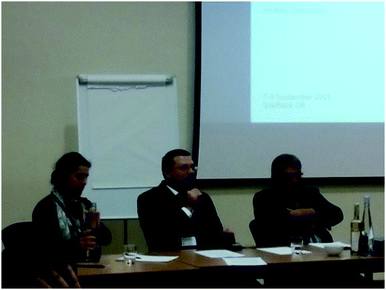 | ||
| Fig. 6 Presenters of Session 5. From left to right, Dr Karolien Vanbroekhoven, Dr Gonçalo Carrera and Prof Michele Aresta. | ||
A wide-ranging discussion followed with a particular interest in the potential for algae to be used for CO2 uptake. The speakers and audience argued that both higher value chemicals alongside fuels need to be produced for the economics to add-up and that separation of the products is still a challenge. Broader questions were also asked about whether these biomimetics or biotransformations should be compared to the efficiency of nature. André Bardow argued that we should not benchmark against nature because it is not optimised for the production of these chemicals. But we should benchmark, for example by comparing the use of photovoltaics for electricity versus chemicals production.
A quote that stood out came from Michele Aresta: “researchers have to explore the forest; the government or market will choose the best tree”. This seems to be highly relevant to the whole CO2 utilisation field and the discussions held over the Faraday Discussion meeting. We do not know yet what will be discovered and which avenue of research will have the biggest impact for the environment, the economy and society, but the endeavour is important to develop new opportunities for chemistry and for society.
Socials
As so frequently is the case at conferences, the social and networking time proved to be some of the most productive. All participants actively engaged in discussing posters (many going on long outside the designated poster time), debating CO2 utilisation opportunities and challenges, and developing collaboration ideas helped along by the excellent wine and nibbles (Fig. 7(a)). Conversations were engaging and a positive atmosphere for learning and socialising was created. Participants received many questions on their posters, both by the judges and the delegates. Several posters attracted much attention from the audience. If a poster presented an area of research that the general audience was familiar with, this allowed a lively discussion on the matter, encouraging new ideas and ways of approaching the research. The appearance of the poster also pulled the attention of the audience; this generated interest in their research and gave a space for conversations on different research areas. The winner of the poster session was named at the conference dinner as Georgina Gregory with the poster titled: “One pot-procedure for the synthesis of cyclic carbonate monomers from 1,3-diols and low CO2 pressure: a novel, mild and safe phosgene alternative” (Fig. 7(b)).The conference dinner allowed further discussion in a relaxed environment and most importantly participation in the famous Loving Cup Ceremony. This came as a particular shock to some of the international delegates, however, everyone joined-in gamely.
Concluding remarks lecture
The concluding remarks were originally to be delivered by Professor Walter Leitner (RWTH Aachen University, Germany). However, he was not able to attend the conference so Professors North and Styring provided an overview of the conference and the state-of-the-art of carbon dioxide utilisation. North highlighted that the combustion of fossil fuels was not the only source of waste carbon dioxide and many other sources such as cement works and chemical plants provided purer carbon dioxide. He also stressed the importance of considering the source of the chemicals the carbon dioxide will react with and provided some examples, stressing the need for all components of the reaction to be sustainable for carbon dioxide utilization to have a central place in the move to a sustainable circular economy.North also pointed out that flue gas is not readily available and that there is a need for an international centre for flue gas utilisation studies. Finally, he reminded the audience of the “CO2CHEMISTRY” mnemonic introduced by Martyn Poliakoff in his opening lecture and highlighted that ignoring some of these principles could be very “COSTLY”:
| C | Catalysis is crucial |
| O | Origin of the CO2 |
| S | Sustainability is essential |
| T | Thermodynamics cannot be beaten |
| L | Large energy input (as opposed to reasonable) |
| Y | Your enthusiasm is not enough |
| This journal is © The Royal Society of Chemistry 2016 |

